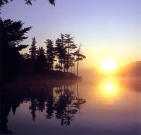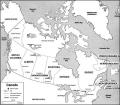Ontario’s Canadian-American Schizophrenia
Oct 2nd, 2004 | By Randall White | Category: Canadian Provinces Almost everyone who very intently watches Ontario government and politics nowadays reads Inside Queen’s Park – the newsletter published by G.P. Murray Research Limited, out of a surviving fine old office building on Adelaide Street in the Toronto financial district. People in Canada’s most populous province generally, however, “do not follow provincial politics as closely as federal politics.” Not everyone will have seen the provocative interview with political scientist Nelson Wiseman, in the September 29, 2004 issue of IQP.
Almost everyone who very intently watches Ontario government and politics nowadays reads Inside Queen’s Park – the newsletter published by G.P. Murray Research Limited, out of a surviving fine old office building on Adelaide Street in the Toronto financial district. People in Canada’s most populous province generally, however, “do not follow provincial politics as closely as federal politics.” Not everyone will have seen the provocative interview with political scientist Nelson Wiseman, in the September 29, 2004 issue of IQP.
As the IQP editors explain, “Dr. Wiseman” currently teaches “at the University of Toronto,” and “has written extensively on Ontario politics and on elections.” But he grew up in the province immediately to the west, and taught for a time at the University of Manitoba, before migrating to the Great Lakes. This often enough gives his Ontario political readings some of the revealing freshness that only the expert observer who comes from afar can bring.
 Dr. Wiseman’s sharpest and most intriguing observation in the September 29 IQP was at the very end of his interview. In response to a question about his current research, he reported that he is “writing a book on Canadian political culture.” He has now reached what “may be the last chapter, on Alberta and British Columbia.” And “what differentiates Ontario from the other regions is its relationship with the United States.”
Dr. Wiseman’s sharpest and most intriguing observation in the September 29 IQP was at the very end of his interview. In response to a question about his current research, he reported that he is “writing a book on Canadian political culture.” He has now reached what “may be the last chapter, on Alberta and British Columbia.” And “what differentiates Ontario from the other regions is its relationship with the United States.”
On the one hand, the “core of English-Canadian nationalism is rooted here in Ontario.” Cases in point are “our cultural industries, all headquartered here,” and the historic “concentration of industry and manufacturing … built up behind tariff walls over a century and more.”
At the same time, especially now that continental free trade has altogether dismantled the historic tariff walls, “Ontario has been the major beneficiary of integration with the American economy.” A major but far from only example is “the auto industry” (whose current structure dates from the Canada-US Auto Pact of 1965). The result is that “Ontario thus has a somewhat schizophrenic political culture in relation to the U.S.”
 Ontario residents who like to complain about the influence of the US oil industry in Alberta might be particularly interested in Nelson Wiseman’s observation here.
Ontario residents who like to complain about the influence of the US oil industry in Alberta might be particularly interested in Nelson Wiseman’s observation here.
It is apparently true enough, according to a Canadian Press report from this past August, that the US Consulate in Calgary “believes southern Alberta has one of the largest concentrations of US citizens living outside their country in the world.” Yet, as Dr. Wiseman’s observation implies, southern Ontario must also be home to another such concentration, of no inconsiderable size.
It is true enough as well that Canadian-American schizophrenia in Ontario already has its own quite long pedigree. The second lieutenant governor of the modern province, William Pearce Howland (1868-1873), was “popularly named … Yankee Howland … owing to his American birth and upbringing” (as a local text of the early 20th century explains).
In the past few decades too, Ontario has had at least one cabinet minister who might have had a similar Yankee prefix attached to (in this case) her name. But this habit – also not unknown in the American South, where the family of the celebrated Chief Justice of Upper Canada, John Beverly Robinson, came from – has apparently now died out.
 A major objective of the old high tariff walls themselves was to lure branch plants from the adjacent northern US manufacturing heartland into central Canada. The dynamic at work here was clearly laid out, with much statistical detail, in a landmark study called Canadian-American Industry, first published as long ago as the 1930s. And as Toronto’s expatriate British historian Goldwin Smith observed in the 1890s, “Ontario is an American state, of the northern type.”
A major objective of the old high tariff walls themselves was to lure branch plants from the adjacent northern US manufacturing heartland into central Canada. The dynamic at work here was clearly laid out, with much statistical detail, in a landmark study called Canadian-American Industry, first published as long ago as the 1930s. And as Toronto’s expatriate British historian Goldwin Smith observed in the 1890s, “Ontario is an American state, of the northern type.”
The highly influential (but quite demographically challenged) myth of the American Loyalists, who on some strictly rhetorical accounts are still sometimes said to have founded modern Ontario in the late 18th century, offers further cases in point.
In the first place, insofar as several thousand authentic American Loyalists really did move north of the Great Lakes in the wake of the War of Independence, it is worth noting that they came from what is now the United States. And they brought many new American economic and cultural habits with them. (Even today some accounts of Ontario history almost make it seem as if the United Empire Loyalists came from the United Kingdom.)
 More strikingly, actual Loyalist political refugees from the American Revolution were not all that numerous among the people who started the modern English-speaking mass settlement frontier in what is now called Ontario, in the late 18th and early 19th centuries. On the eve of the War of 1812 the great majority of the new settlers in the old province of Upper Canada had come from the same wave of continental frontier migration that settled such neighbouring places as western New York, Ohio, and Michigan.
More strikingly, actual Loyalist political refugees from the American Revolution were not all that numerous among the people who started the modern English-speaking mass settlement frontier in what is now called Ontario, in the late 18th and early 19th centuries. On the eve of the War of 1812 the great majority of the new settlers in the old province of Upper Canada had come from the same wave of continental frontier migration that settled such neighbouring places as western New York, Ohio, and Michigan.
As explained as long ago as the early 1960s, by the authoritative modern historian of Upper Canada: “They came to find a suitable field for their talents and energies, ready to find that field anywhere on the continent. Now it was Upper Canada, but in twenty years’ time some of their kind would be as ready to move into the Mexican province of Texas, always searching for the best opportunities.”
Nowadays as well Ontario historians understand that the roots of the modern province stretch back considerably further than the late 18th century. And here too there are recurrent cases of assorted ancestral branches of Canadian-American schizophrenia.
 The fur-trade outpost that the French regime established on the banks of what is now called the Humber River in Toronto, in the late 1720s, is said to have been “a dependency” of a much more impressive stone structure erected at Fort Niagara, by the engineer Gaspard-Joseph Chaussegros de Lery in 1726. You can visit de Lery’s impressive structure today. It still stands proudly, with a commanding view of Lake Ontario, and it has been nicely maintained. But to reach it from Ontario you have to go across the Niagara River, to Lewiston, New York.
The fur-trade outpost that the French regime established on the banks of what is now called the Humber River in Toronto, in the late 1720s, is said to have been “a dependency” of a much more impressive stone structure erected at Fort Niagara, by the engineer Gaspard-Joseph Chaussegros de Lery in 1726. You can visit de Lery’s impressive structure today. It still stands proudly, with a commanding view of Lake Ontario, and it has been nicely maintained. But to reach it from Ontario you have to go across the Niagara River, to Lewiston, New York.
Heritage enthusiasts in Windsor, Ontario today are similarly justly proud of the longevity of their original French Canadian (or Canadien, or franco-Ontarian) community – whose continuous history reaches well back into the 18th century. But it is also true that it was just a spillover from the community across the Detroit River, which grew up around the French fort established by Antoine de la Mothe Cadillac in 1701, on the site of the present Motown, USA.
The modern history of southern Ontario’s present Toronto metropolis itself can probably be most realistically dated from a string of villages and fur-trade outposts established on the north shore of Lake Ontario in the 1660s, by assorted Iroquois nations from what is now upstate New York. The Seneca and the Cayuga (and perhaps a few Mohawks and others) were, so to speak, the first ambassadors of New York City business interests in the central Canadian hinterland.
 Archaeologists nowadays can also trace assorted evidence of parallel interactions among various first nations living north and south of the lakes in northeastern and mid-western North America, back into a much more distant past. One could equally go on and on with many more examples of all manner of such things since the early 1600s, when the rising world economy first began to settle into the primeval Ontario forest.
Archaeologists nowadays can also trace assorted evidence of parallel interactions among various first nations living north and south of the lakes in northeastern and mid-western North America, back into a much more distant past. One could equally go on and on with many more examples of all manner of such things since the early 1600s, when the rising world economy first began to settle into the primeval Ontario forest.
None of this deep historical background suggests that Nelson Wiseman is not making a very apt talking point when he draws special attention to Ontario’s “somewhat schizophrenic political culture in relation to the US” today. Over the past half century the “core of English-Canadian nationalism … rooted here in Ontario” has too often tried to keep the American side of its traditional Canadian-American schizophrenia too much in the closet.
In one way or another, the condition is shared by Canadians in all parts of the country (and in both official languages). We are not somehow exempt in Ontario, and the condition is quite treatable. It is just another part of the rising 21st century theme of multiple Canadian identities. It would be refreshing to talk about it more openly than we still usually do.
 What’s more, talking like this – and pursuing Nelson’s Wiseman’s apt observation in greater depth, as it were – would not be any threat at all to the continuing future of the rising Canadian political nation in the most northern part of North America today. Quite the opposite, in fact. Telling the truth about such things always makes you stronger.
What’s more, talking like this – and pursuing Nelson’s Wiseman’s apt observation in greater depth, as it were – would not be any threat at all to the continuing future of the rising Canadian political nation in the most northern part of North America today. Quite the opposite, in fact. Telling the truth about such things always makes you stronger.
(And, as Arthur Schlesinger Jr. has just recently reminded us in the New York Review of Books: “Americans, unlike the Romans, the British, and the French, are not colonizers of remote and exotic places. We … as James Bryce wrote in 1888, have none of the earth-hunger which burns in the great nations of Europe.’ … Some of our political leaders did. Jefferson said that the United States ought, at the first possible opportunity, to take Cuba.’ John Quincy Adams agreed, considering the annexation of Cuba indispensable to the continuance and integrity of the Union itself.’ Adams wanted and expected Canada, too. These things, so authoritatively predicted, never came to pass. The United States has not annexed Cuba or Canada. There is no likelihood that we ever will.”)
Randall White is the author of Ontario 1610-1985: A Political and Economic History (Dundurn Press, 1985), and Ontario Since 1985 (eastendbooks, 1998).
